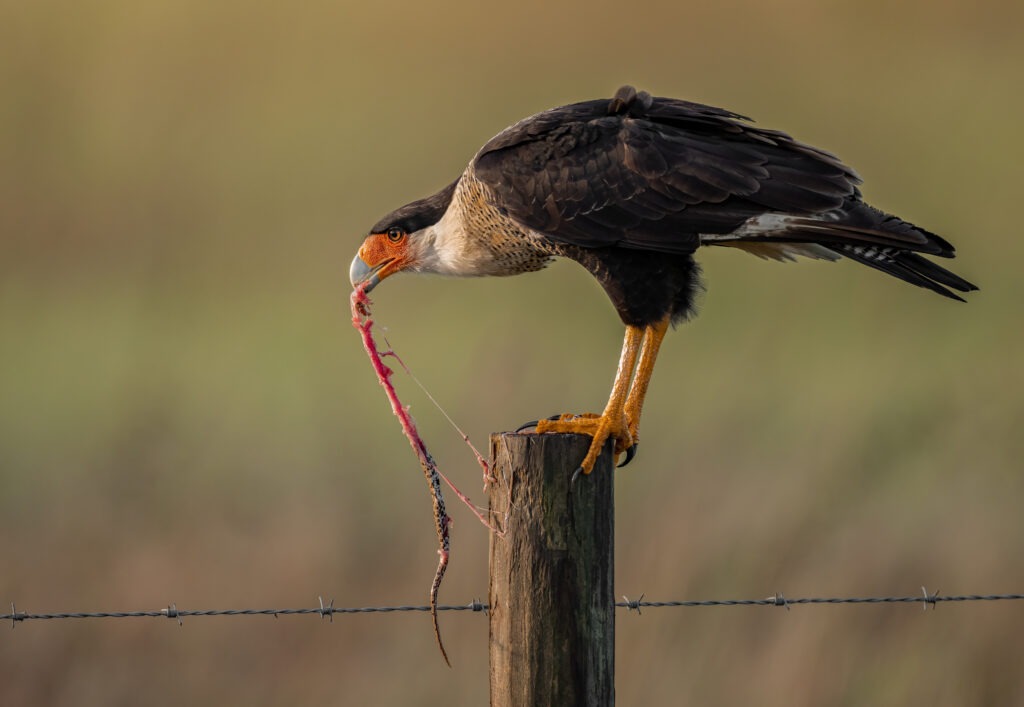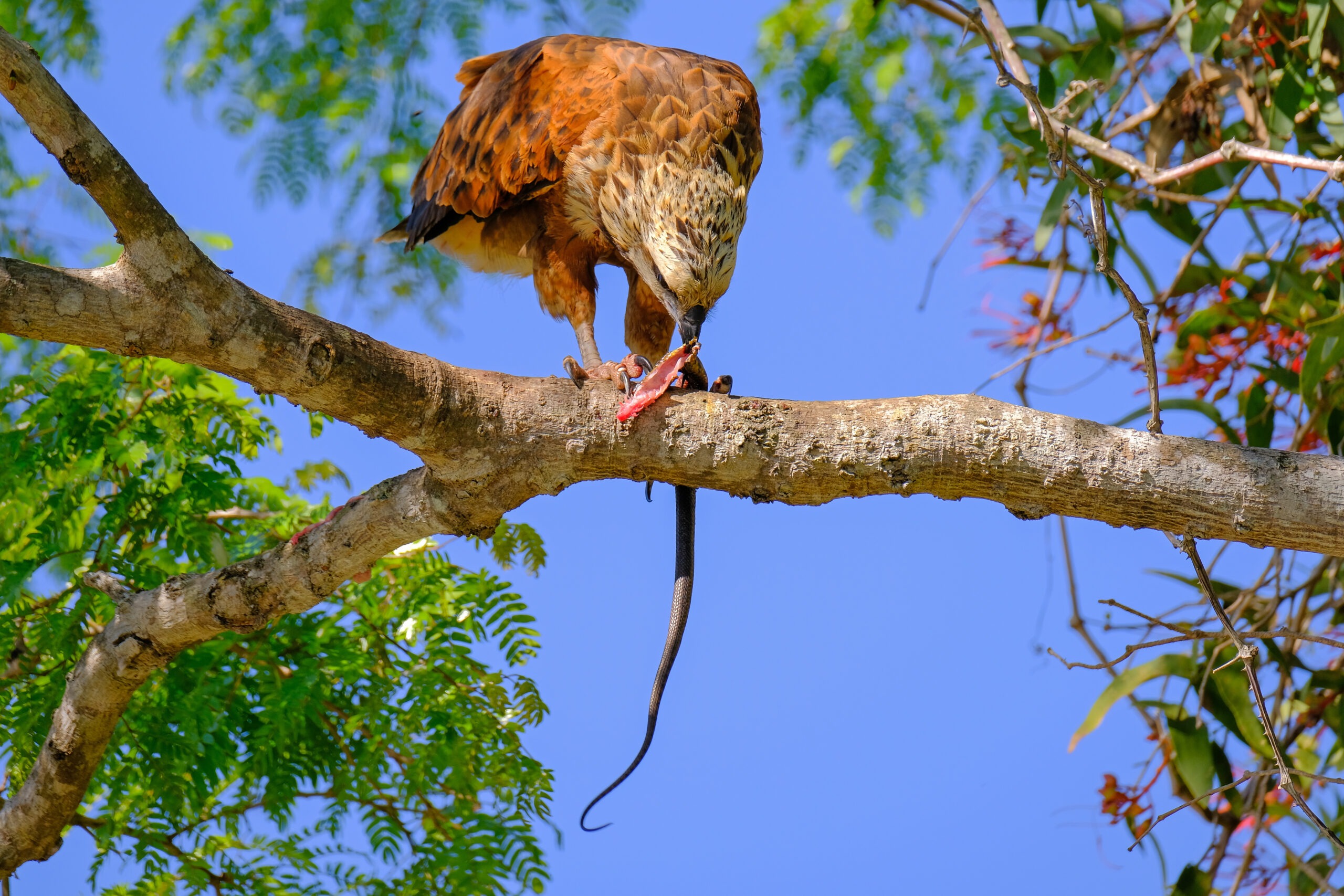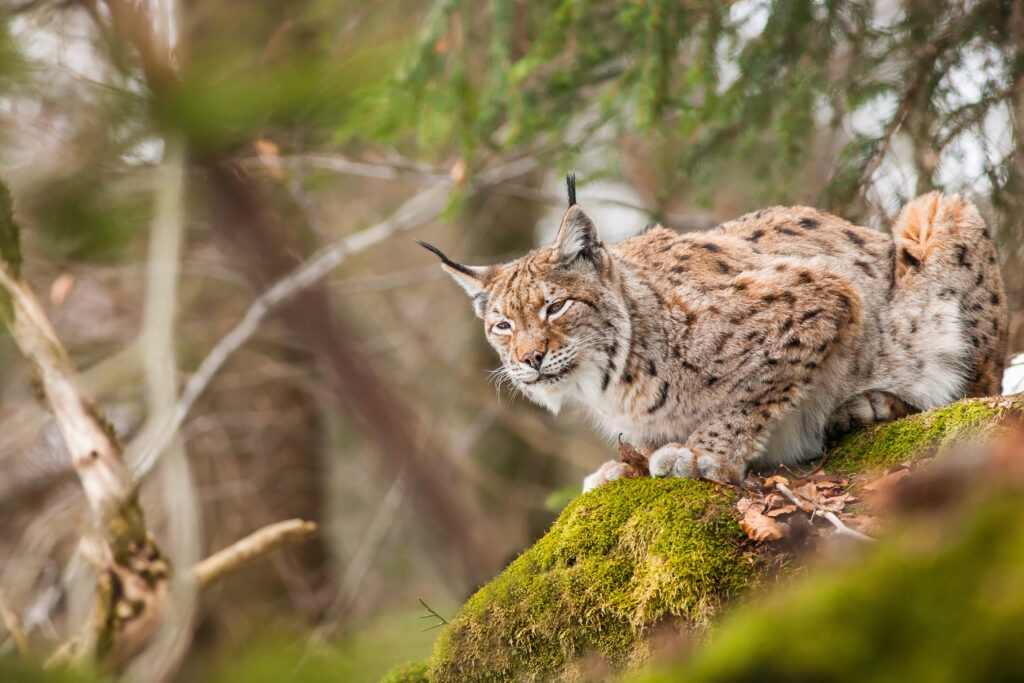
Rattlesnakes are well-known as dangerous predators in the animal kingdom. But as scary as rattlesnakes may seem, they too are a source of food for many different animals. So what are the natural predators of a rattlesnake?
Here’s what I’ve seen:
The most common predators of rattlesnakes are other snakes such as king snakes, birds such as roadrunners, eagles, and hawks, and other land mammals such as foxes or coyotes. Even Bullfrogs prey upon rattlesnakes.
However, the specific animals that prey on rattlesnakes vary depending on what region they live in.
Although rattlesnakes appear to be one of the toughest animals out there, there are over 20 different animal species that feed upon them.
Keep reading to find out which animals are tough enough to take down a rattlesnake!
Predatory Snakes That Kill Rattlesnakes
It may be surprising to learn that the majority of the rattlesnake’s predators are actually just other snakes.
Each of the snakes below has a unique feature that allows them to successfully hunt rattlesnakes. Snakes have no issue eating each other. Many of these reptilian predators discovered that sometimes the best food source around is the one that follows the same habits they do.
Indigo Snakes
On the east coast and in the south, a rattlesnake’s most common predator is the indigo snake. Studies done by Fish Wildlife Service have found that the indigo snake is immune to rattlesnake venom, so even if they get bit, the indigo snake can easily obtain its meal. Combine that venom immunity with the indigo snakes’ large, powerful jaws and it is easy to see why rattlesnakes make easy prey for them.
Cottonmouth Snakes
Cottonmouth snakes are related to the rattlesnake in that they are both pit vipers. Cottonmouths have been known to kill and eat rattlesnakes, especially smaller babies that they can more easily overpower.
Southern Black Racers
Southern black racers pose a large threat to rattlesnakes in the eastern United States, especially in Florida. Southern black racers are long, slender snakes that can grow to be about six feet long and are incredibly fast. They are opportunistic feeders and if they come across a smaller rattlesnake, they will dart in at lightning speed, bite the rattler on the neck and hold on until it suffocates.
Common Kingsnakes
Kingsnakes are one of the most common snake breeds in North America and are frequently kept as household pets. Kingsnakes and rattlesnakes actually share a biological feature.
While a rattlesnake shakes its tail to warn predators of its presence, king snakes produce an odorous musk and shake their tails, according to Live Science. Although King snakes do not possess a rattle on their tail, they also share the same venom immunity as the Indigo Snake, allowing them to hunt rattlesnakes.
The Kingsnake then constricts the rattlesnake and eats them whole.
Coachwhip Snakes
Although the coachwhip snake’s diet primarily consists of lizards and small mammals, they do occasionally prey upon rattlesnakes as well.
The coachwhip’s main advantage over rattlesnakes is its speed and stealth. Like the racer, it will move in quickly and grab the throat of the rattlesnake in its jaws and squeeze until the rattler suffocates.
Harlequin Coral snakes
Coral snakes inhabit both North and South America and feed partially on other snakes around them.
Coral snakes are also venomous and have some of the most powerful venom in the world. Because coral snakes are reclusive and non-aggressive and have a less effective venom delivery system, they are responsible for far fewer snakebites in the US than rattlesnakes. They do however prey on rattlesnakes if they can catch and kill a smaller specimen.
Watch this video to see a coral snake swallowing a copperhead whole!
Amphibian Predators of Rattlesnakes
Although rattlesnakes are not commonly preyed upon by amphibians, they do occasionally become the meal of some frogs, such as the American bullfrog.
Bullfrogs are excellent hunters and will eat anything they can stuff into their mouths, including baby rattlesnakes. They are native to the eastern half of the United States but have been introduced to the western half where they are an invasive species that is out-competing other animals there.
Because of this, the bullfrog species has started to negatively impact the population growth of other species, including the prairie rattlesnake, according to the Montana Field Guide.
While conservationists work to control the American bullfrog, many native populations of frogs, lizards, and snakes continue to dwindle under its presence.
Predatory Birds That Kill Rattlesnakes

It’s probably less surprising to see predatory birds on this list of rattlesnake predators. Birds are well-equipped to drop in on rattlesnakes, making them easy prey. Learn more about the birds that prey on rattlesnakes below!
Great Horned Owls
Great horned owls are phenomenal hunters due to their excellent night vision and remarkable hearing. Not only are owls able to easily locate their prey, but they can then approach them without making much of a sound. Although adult rattlesnakes are larger prey than great horned owls generally prefer, they may still go after them from time to time.
If a great horned owl targets a rattlesnake though, there is a good chance they will choose younger rattlesnakes that are smaller.
Red-Tailed Hawks
Red-Tailed Hawks are known for their impeccable eyesight. They are fast too! They are skilled in spotting, swooping down, and snatching their prey when hunting for food.
Luckily for rattlesnakes, red-tailed hawks are not immune to their venom; however, that doesn’t keep them completely safe. Occasionally a red-tailed hawk will successfully capture a rattlesnake as its meal.
See how easily a red-tailed hawk can take down a rattlesnake in the video below!
Crested Caracaras
The Crested Caracaras, also known as the Mexican eagle, is native to Mexico and parts of the southern United States. It typically feeds on dead animals but will catch and kill rattlesnakes if the opportunity presents itself.
Turkeys
Surprisingly, turkeys are well-equipped to take on a rattlesnake and win.
Turkeys usually travel in groups and will work together to peck the head of a rattlesnake and then tear it apart and eat it once it is dead.
While snakes, particularly rattlesnakes, may not be a go-to choice for turkeys, when it comes down to it, a turkey can easily kill a rattlesnake.
Mammalian Predators of Rattlesnakes

Bison and Related Animals
While not technically a predator of the rattlesnake, bison, and hooved vegetarians do pose a danger to rattlesnakes.
Bison, cows, horses, deer, and antelope will use their hooved feet to defensively stomp any rattlesnakes that approach them.
However, these animals will generally avoid rattlesnakes before they get close enough to stomp on them. They also won’t eat the snake once it is dead. The rattlesnake species that is primarily threatened by these hooved creatures are prairie rattlesnakes.
Wild Hogs
Wild Hogs have been known to greatly impact rattlesnake populations for a very long time.
A perfect example of this took place in Seminole County, Florida. An article in the Orlando Sentinal explained that rattlesnakes were once a prevalent species in the area. However, wild hogs have preyed upon rattlesnakes for so long that they are now hard to find.
Raccoons
It has been commonly acknowledged that raccoons are incredibly clever creatures. Raccoons are unique because they have been observed using objects as tools for a variety of purposes, including hunting. According to Wildlife Removal USA, raccoons have been known to hunt snakes by smashing their heads with rocks.
This helps protect the raccoon from any venomous bites. Raccoons and rattlesnakes inhabit similar ecosystems and it is, therefore it is likely that raccoons are sometimes feeding on them.
Black Bears
Black Bears are not one of the more prominent predators of rattlesnakes, but they are still a predator nonetheless.
Until recently, black bears were believed to avoid rattlesnakes. However, while completing a wildlife conservation study for Penn State, a bear was observed eating multiple rattlesnakes.
Being much larger and having a thick protective coating of fat and fur allows black bears to prey upon rattlesnakes. However, researchers are still not sure how often black bears actually choose to hunt rattlesnakes.
Striped Skunks
Skunks, just like Black Bears, aren’t one of the primary predators of a Rattlesnake. However, they are more equipped to eat these venomous snakes than many other mammals. Like the Indigo Snake and King Snakes, skunks are immune to rattlesnake venom.
This venom immunity allows them to both be struck by and to eat rattlesnakes without becoming ill.
Coyotes
Coyotes are quite fearless when it comes to hunting.
They have a very powerful bite that allows them to be effective when hunting. While coyotes may hunt larger animals in packs, they also consistently eat smaller animals such as rattlesnakes too.
A coyote does not need to be immune to the venom in order to avoid falling ill, it only needs to avoid being bitten by the rattlesnake’s fangs.
Bobcats
Bobcats and coyotes hunt rattlesnakes in similar ways.
Both animals will stalk the rattlesnake until it can be easily ambushed. With just one well-located bite, a bobcat can take a rattlesnake for its meal. However, Bobcats do not always get off so easy. Rattlesnakes can kill bobcats because they are not immune to rattlesnake venom.
Watch this young bobcat take on a rattlesnake and win in the following video!
Domestic and Feral Cats
Cats are curious animals and have lightning-fast reflexes to help them avoid the similarly fast strike of a snake. Because of this, it is not uncommon to see cats, even domestic cats, taking on a rattlesnake.
While cats are excellent hunters, as we saw in the video above, domestic cats do not usually eat rattlesnakes. Rather, cats will merely kill the snake and leave.
Sometimes, a cat may even play with a snake for fun!
Foxes
Although foxes hunt at any time of the day, they are primarily nocturnal hunters. Because of their excellent hearing, foxes can easily locate and stalk prey such as rattlesnakes. Foxes can even hear animals moving underground!
While foxes are not immune to snake venom, they still choose to eat several kids of venomous snakes. Once a rattlesnake has been located, the fox will either dig up its hiding place or pounce on top of it.
Opossums
It is hard to think that an animal that plays dead when startled is able to take on a snake as dangerous as the rattlesnake and win, but surprisingly they do. Opossums are nocturnal hunters and are able to eat not just rattlesnakes, but a variety of other pests or parasitic creatures without trouble.
According to Tree Hugger, possums have a naturally low body temperature that protects them from contracting diseases such as rabies.
As well as avoiding rabies, opossums have an extreme tolerance for venom, no matter what animal it comes from. Opossums can be stung by bees and scorpions or bitten by rattlesnakes without falling harm to their venom. In fact, opossums play a part in the development of a low-cost rattlesnake antivenom!
Humans
Perhaps the most dangerous predator of the rattlesnake is the human. Humans who encounter rattlesnakes on hikes or around their homes are quick to react aggressively. However, when left alone, rattlesnakes will likely leave you alone too.
While many people kill rattlesnakes to avoid being bitten, some humans do hunt rattlesnakes for meals. According to some rattlesnake eaters, the meat tastes similar to more common delicacies such as frog legs, fish, or even chicken.
